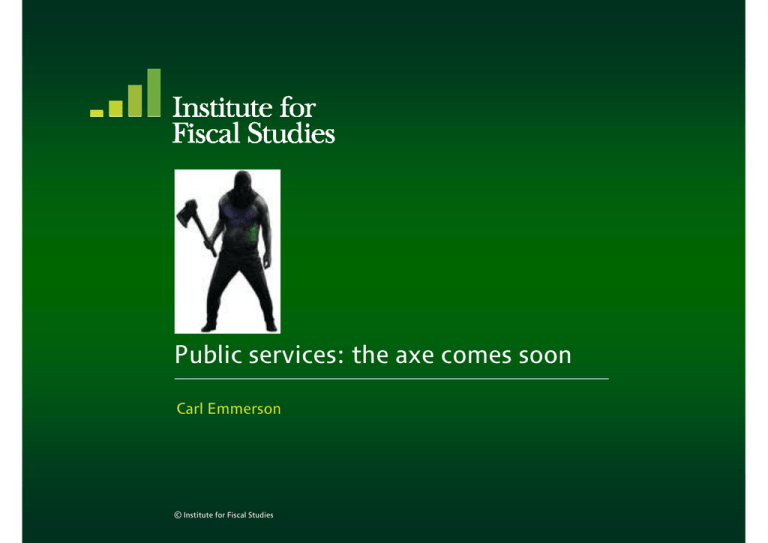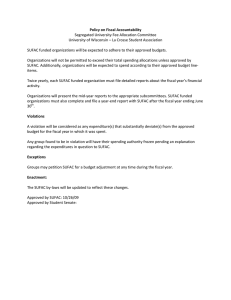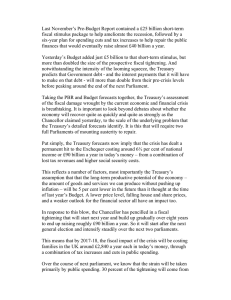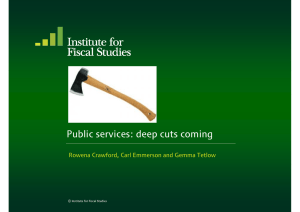Public services: the axe comes soon Carl Emmerson
advertisement

Public services: the axe comes soon Carl Emmerson © Institute for Fiscal Studies Public spending: summary • Budget added to departmental spending in 2010–11 – increased spending p g on higher g education and roads • Over four y years from April p 2011: – little change since Pre-Budget Report – additional spending p g in 2010–11 slightly g y increases cuts thereafter – current policies imply deep cuts to spending on public services • Announced real cuts to public sector pay and axing of some lower value spending will help – additional contribution of efficiency savings less clear © Institute for Fiscal Studies Growth in components of spending: 2011–12 to 2014–15 Total Managed Expenditure 00 0.0 Of which: Debt interest 12.7 Social security 1.1 Other AME 3.1 Departmental Expenditure Limits -3.1 -5 0 5 10 Average annual percentage real increase © Institute for Fiscal Studies Source: IFS calculations based on figures from HM Treasury 15 © Institute for Fiscal Studies Sources: HM Treasury; IFS calculations. 201 14-15 201 13-14 201 12-13 201 11-12 201 10-11 200 09-10 200 08-09 200 07-08 200 06-07 200 05-06 200 04-05 200 03-04 200 02-03 200 01-02 200 00-01 199 99-00 199 98-99 Pe ercentage e of natio onal incom me Public services spending: back down the hill 30 27 24 21 18 15 But some areas are to be ‘protected’... • Overseas Development Assistance – meet 2013 target g of spending p g 0.7% of Gross National Income In 2011–12 and 2012–13: • Health – real freeze in “front-line” NHS spending • Education – 0.7% real increase in “front-line” schools spending – 0.9% 0 9% real increase in “front-line” front line spending on 16 16-19 19 participation – real freeze in “front-line” spending on Sure Start • Treasury still haven haven’tt provided costings for these commitments © Institute for Fiscal Studies Cumulative spending changes to 2012–13 Cumu ulative p percentage change 5 +1.6% 0 -5 –6.6% -10 -15 -20 -25 25 2010–11 © Institute for Fiscal Studies DELs –14.1% 'Protected' DELs 'U 'Unprotected' d' DELs DEL 2011–12 2012–13 Source: IFS calculations based on figures from HM Treasury 2013–14 2014–15 Cumulative spending changes to 2014–15? Cumu ulative p percentage change 5 0 -5 -10 -15 -20 -25 25 2010–11 © Institute for Fiscal Studies –11.9% 11 9% DELs 'Protected' DELs 'U 'Unprotected' d' DELs DEL 2011–12 2012–13 Source: IFS calculations based on figures from HM Treasury 2013–14 2014–15 Cumulative spending changes to 2014–15? Cumu ulative p percentage change 5 0 –3.6% -5 -10 -15 -20 -25 25 2010–11 © Institute for Fiscal Studies –11.9% 11 9% DELs 'Protected' DELs – "2yr protection" 'U 'Unprotected' d' DELs DEL – "2yr "2 protection" i " 2011–12 2012–13 Source: IFS calculations based on figures from HM Treasury –19.5% 2013–14 2014–15 Cumulative spending changes to 2014–15? Cumu ulative p percentage change 5 +2.9% 0 -5 -10 -15 -20 –11.9% 11 9% DELs 'Protected' DELs – "2yr protection" 'Unprotected' Unprotected DELs – "2yr 2yr protection" protection 'Protected' DELs – "4yr protection" 'Unprotected' DELs – "4yr protection" -25 25 2010–11 © Institute for Fiscal Studies 2011–12 2012–13 Source: IFS calculations based on figures from HM Treasury 2013–14 –25.4% 25 4% 2014–15 Claimed savings so far • Cuts to DELs total £25bn by 2012–13 rising to £46bn by 2014–15 2012–13 13 Treasury estimates: • By 2012 – 1% cap on public-sector pay to reduce spending by £3.4bn – cuts to lower value spending p g worth £5bn – cap on employer-pension contributions saves £1bn – efficiency y savings g of £11bn • Do these contribute to deficit reduction and has the financial crisis led to them happening? – lower public sector pay: yes and yes – cuts to lower value spending: yes and quite possibly – public sector pensions: yes and very doubtful – efficiency saving: unclear in either case © Institute for Fiscal Studies Efficiency savings • Treasury claims £11bn by 2012–13 • Had the financial crisis not happened what would have been claimed over this period? – targeted £21.5bn between 2004–05 and 2007–08 under Gershon Review and claims achieved £26.5bn – targeted £30bn between 2007–08 and 2010–11 under 2007 CSR and increased this to £35bn under Operational Efficiency Programme • Will efficiency savings be delivered as expected? – £26 £26.5bn: 5bn: NAO audit half-way through suggested: 25% did not adequately demonstrate true efficiencies, another 50% questionable – £35bn: less than one-third (£10.8bn) found by Autumn 2009, another £24bn needed before April 2011 © Institute for Fiscal Studies Deficit reduction and efficiency savings • Without spending limits being set not possible to say what the contribution of each department is to the deficit reduction • Genuine efficiency savings within ‘protected’ budgets boost service quality in those areas rather than reduce borrowing © Institute for Fiscal Studies Efficiency savings (2012–13) Health CLG Local Government Children Schools and Families D f Defence Work and Pensions Home Office: Arm's length H Home Offi Office: P Police li Justice Business, Innovation and Skills CLG Communities Environment, Food and Rural Affairs International Development Transport Culture, Media and Sport Energy and Climate Change Cabinet Office 44 4.4 2.1 1.1 0.7 07 0.4 0.4 03 0.3 0.3 0.3 0.2 0.2 0.2 0.1 0.1 0.0 0.0 0 © Institute for Fiscal Studies 'Unprotected' ' 'Protected' d' Total across these departments £10.7bn, split 50/50 ‘protected’ and ‘unprotected’ 1 2 £ billion billi Source: Various departmental websites; IFS calculations 3 4 5 Efficiency savings (2012–13) CLG Local Government Home Office o e t, Food ood and a d Rural u a Affairs a s Environment, Health Work and Pensions Justice Culture, Media and Sport International Development Children Schools and Families CLG Communities Defence Business, Innovation and Skills Cabinet Office Energy and Climate Change Transport 8.0% 6.7% 6.3% 4.0% 3.7% 3.6% 2.8% 1.9% 1.9% 1.9% 1.7% 1 4% 1.4% 1.0% 0.9% 0 6% 0.6% 'Unprotected' p 'Protected' 0.0% 2.0% 4.0% 6.0% 8.0% Percentage of 2010–11 DEL © Institute for Fiscal Studies Source: Various departmental websites; IFS calculations 10.0% Public spending: summary • Little change since PBR; over four years from April 2011 – total p public spending p g broadly y flat after economy-wide y inflation – debt interest and, under current policies, welfare benefits and other annually managed expenditure to continue rising – implies deep cuts for public service spending – and much deeper cuts elsewhere if large areas such as the NHS and schools exempted from cuts • Announced real cuts to public sector pay and axing of some lower value spending will help – cuts to employer-contributions to public-service pensions Government policy before the crisis began – additional contribution of efficiency savings less clear • Significant welfare spending cuts or further tax rises could alleviate the pain © Institute for Fiscal Studies Post Budget briefing Institute for Fiscal Studies, 25th March 2010 www.ifs.org.uk © Institute for Fiscal Studies





